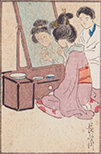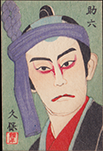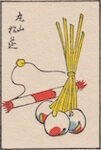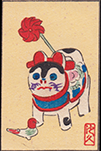Gallery 8: Matchbox Prints
Shoki the Demon Queller. 1920s to 1930s. 3.6 x 5.5 cm
The miniature woodblock prints in this gallery were designed as matchbox labels. The collecting of matchbox labels, like the collection of other ephemera in Japan, became popular shortly after their introduction in the late 1800s. In 1903, the Japanese Association of Matchbox Label Collectors was established. The majority of the labels in this collection are affixed within two collector’s books or are from another large collection that was not presented in a book format,These date from the 1920s or 1930s. Others derive from smaller sets designed around specific themes (e.g. women, historical events). These prints represent some of the smallest of Japanese miniatures. The most elaborate of these labels are a testimony to the amazing skill of the carvers and printers who produced them.
Most matchbox prints do not have an identifiable artist. Information will be added as it becomes available. Additional matchbox prints can be seen in Galleries 8A (Theater Matchbox Series) and 8B (Landscape Matchbox Series). Prints are approximately 3.1-3.3 by 5.1-5.2 cms in size unless otherwise indicated.
This set of matchbox prints illustrates the seven lucky gods (shichi fukujin).
Hasegawa Sadanobu III (Konobu III) (1881-1963)
Kyoto Beauties: Twelve Maiko. Twelve matchbox prints with envelope. August, 1930.
Hasegawa Sadanobu III (Konobu III) (1881-1963)
A set of six prints that are likely related to Kabuki performances.
This set of 12 prints is by a yet to be identified artist. Interestingly, the same seal and calligraphy appear on the above set by Hasegawa Sadanobu III. This likely refers to the publisher rather than the artist who created these images.
Matchbox prints by Kiyose Ryoichi. The first four prints are clearly woodblock printed. The embossed prints are on thick paper and are assumed to be created using the woodblock printing technique based on the artist’s other work. All date to the 1930s.
The folllowing are matchbox process sets demonstrating the progressive addition of colors during the woodblock printing process. These sets were distributed at the 1930 Matsuzakaya Exhibition (Osaka University) of Matchbox prints. The disigns depict elements from Utamaro’s woodblock prints of albone Divers. The sets appear to include a second copy of the final image which is presented first..
The matchbox prints in this section all come from a book related to a matchbox print exchange that occurred in 1933. The cover indicates this was the 15th exchange for the group. Many of the matchbox prints represent small series based on a theme such as kabuki, travel, toys, a honeymoon, etc. Since these appear in a single exchange book, we have chosen to keep all of these sets in this section rather than relocate them to the galleries specifically focused on one genre such as travel or theater.
A Collection of Matchbox Prints from a single collector. Artists have not been identified.
A set of 9 matchbox prints representing toys.
Three Kabuki Related Matchbox prints
The prints in this section are singed by the artist Yamakawa Seisen and came from a collection of matchbox prints owned by a family whose ancesters were woodblock carvers and matchbox print collectors. The second image text reads Shukuseikai and Japan Rinka Renmei.
The following set of 24 matchbox prints depict different aspects of the story Chūshingura (The Treasury of Loyal Retainers) which recounts an episode at the begininng of the eighteenth century in which forty seven-ronin (samaria without a lord or master) avenged the death of their master, Asano Naganori. The story has been told in multiple formats including kabuki, bunraku, novels, film, and television. Most of these prints refer to specific scenes for the play although several also depict ronin who play minor parts in the stage production.
Act 1: Enya Hangan's wife Refuses to Accept a Love Letter from Moronao
Act 3: Enya Hangan Attacking Moronao
Act 4: Enya Hangan's Retainer's Rushing to Hangan's Castle with Instructions How to Proceed
Act 4: Okaru Persuades Kanpei Not to Kill Himself
Act 4: Yuranosuke After Surrendering the Castle
Act 5: Sadakurō after Robbing and Killing Yoichibei
Act 7: Kudayū Trying to Spy on Yuranosuke's Letter
Act 7: Heiemon Ready to Kill Okaru
Act 7: Yuranosuke Acts Drunk and Dissipated as Moronao's Spy Kudayū Looks at Him
Ronin Horibe Yasubei' Duel at Takadanobaba
Act 10: Testing the Loyalty of Merchant Gihei
Act 11: Breaking into Moronao's Palace
Act 11: Attack on Moronao's Palace
Act 11: Fighting Inside Moronao's Palace
Act 11: Fighting in the Garden of Moronao's Palace
Act 11: Capture of Moronao
The following set of matchbox prints depict the different ronin and others in the story Chūshingura (The Treasury of Loyal Retainers). As noted above, the story recounts an episode at the beginning of the eighteenth century in which forty-seven ronin (samaria without a lord or master) avenged the death of their master, Asano Naganori. This appears to be an incomplete set, as there are only 44 portraits. Images are approximately 3.6 x 5.4 cm.
This set of 42 images of Bijin-ga (Beautiful Woman prints) was reportedly printed in the 1920s. The images appear to be adaptations of various elements of works by the artist Kitagawa Utamaro (c. 1753 – 1806). Images (without margins) are approximately 3.3 x 5.1 cm in size.
A set of matchbox prints featuring rabbits printed in association with the 1930 National Match Label Exhibition.























































































































































































































































































































































































































































































